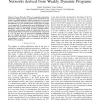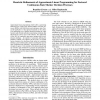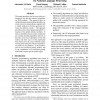6149 search results - page 35 / 1230 » Revealing the programming process |
98
Voted
SAMOS
2010
Springer
14 years 11 months ago
2010
Springer
—Process Networks (PNs) is an appealing computation ion helping to specify an application in parallel form and realize it on parallel platforms. The key questions to be answered ...
114
click to vote
FASE
2000
Springer
15 years 4 months ago
2000
Springer
Abstract. We introduce a generalised notion of a real-time speci cation language (\GPLC-Automata") that can be translated directly into real-time programs. In order to describ...
102
Voted
AIPS
2004
15 years 2 months ago
2004
Approximate linear programming (ALP) offers a promising framework for solving large factored Markov decision processes (MDPs) with both discrete and continuous states. Successful ...
99
Voted
EMNLP
2010
14 years 10 months ago
2010
This paper introduces dual decomposition as a framework for deriving inference algorithms for NLP problems. The approach relies on standard dynamic-programming algorithms as oracl...
122
Voted
OL
2011
14 years 3 months ago
2011
In this paper we present a methodology for finding tight convex relaxations for a special set of quadratic constraints given by bilinear and linear terms that frequently arise in ...



